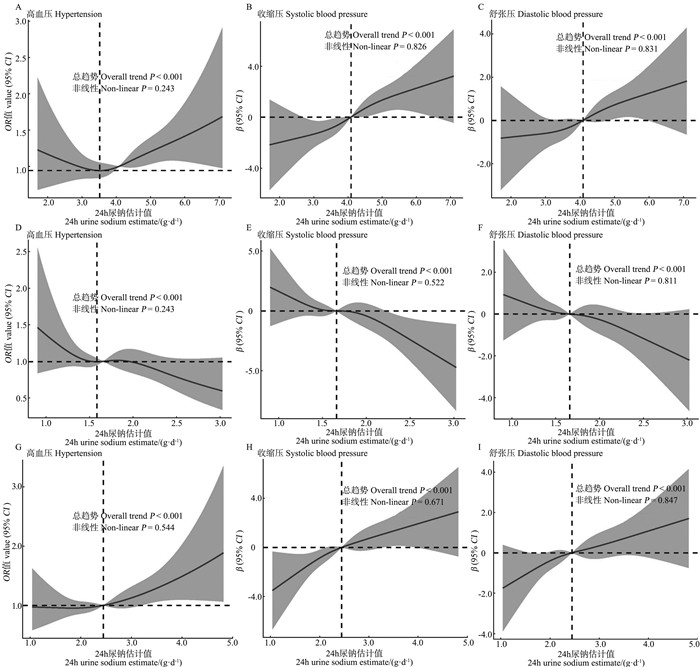Association between urinary sodium and potassium excretion and blood pressure among adults in Shandong Province, China
-
摘要:
目的 分析山东省居民尿钠钾水平与高血压患病风险及血压水平的关系。 方法 2019年在山东省选取18~69岁居民进行问卷调查、体格测量及随机点尿采集。通过Tanaka公式以点尿估计24 h尿钠钾水平,采用限制性立方样条、logistic回归分析模型和线性回归分析模型分析24 h尿钠钾水平与高血压患病风险及血压水平的剂量-反应关系及关联模式,并按年龄、性别和是否服用降压药进行亚组分析。 结果 共纳入3 280人,24 h尿钠、尿钾及尿钠钾比为(4.12±0.95)g/d、(1.70±0.39)g/d和(2.51±0.69)。24 h尿钠升高1 g/d,收缩压升高1.221 mmHg(95% CI:0.611~1.830, P < 0.001)、舒张压升高0.612 mmHg(95% CI:0.201~1.023, P=0.004),24 h尿钾升高1 g/d,收缩压降低2.297 mmHg(95% CI:-3.797~-0.796, P=0.003)、舒张压降低1.159 mmHg(95% CI:-2.171~-0.147, P=0.025)。与尿钠钾比 < 2.0组相比,≥2.9组高血压患病风险增加37%(95% CI:1.062~1.769, P=0.015),收缩压升高3.047 mmHg(95% CI:1.470~4.624, P < 0.001),舒张压升高1.796 mmHg(95% CI:0.734~2.859, P=0.001)。除性别和尿钾与收缩压的关联存在相乘交互作用(P=0.015),其他指标无交互作用。 结论 随尿钠升高、尿钾降低,高血压患病风险、收缩压和舒张压均呈上升趋势,随机点尿用于大型流行病学调查中评估高血压患病风险具有一定科学性。 Abstract:Objective To analyze the association between urinary sodium and potassium excretion with the risk of hypertension and blood pressure levels among adults in Shandong Province, China. Methods Residents aged 18-69 years were selected for questionnaire survey, physical examination, and random spot urine collection in Shandong Province in 2019. The 24 hour urinary sodium and potassium excretion was estimated by spot urine through the Tanaka formula. Dose-response relationship and association of 24 hour urinary sodium and potassium excretion with the risk of hypertension and blood pressure levels using restricted cubic spline, logistic regression models, and linear regression models. Subgroup analyses were conducted according to different ages, genders, and antihypertensive drug usage. Results A total of 3 280 subjects were included, 24 hour urinary sodium, urinary potassium and urinary sodium-potassium ratios were (4.12±0.95) g/d, (1.70±0.39) g/d and (2.51±0.69). For every 1g/d increase in sodium excretion, systolic blood pressure increases by 1.221 mmHg (95% CI: 0.611-1.830, P < 0.001), and diastolic blood pressure increases by 0.612 mmHg (95% CI: 0.201-1.023, P=0.004). For every 1g/d increase in potassium excretion, systolic blood pressure decreases by 2.297 mmHg (95% CI: -3.797--0.796, P=0.003) and diastolic blood pressure decreases by 1.159 mmHg (95% CI: -2.171--0.147, P=0.025). Compared with the group with a urinary sodium-potassium ratio of < 2.0, the ≥2.9 group increases the risk of hypertension by 37% (95% CI: 1.062-1.769, P=0.015), with an increase in systolic blood pressure of 3.047 mmHg (95% CI: 1.470-4.624, P < 0.001) and diastolic blood pressure of 1.796 mmHg (95% CI: 0.734-2.859, P=0.001). There was no interaction for any of the metrics except for a multiplicative interaction for gender and urinary potassium in the association with systolic blood pressure (P=0.015). Conclusions With the increase of urinary sodium and the decrease of urinary potassium, the risk of hypertension, systolic blood pressure and diastolic blood pressure all increase, and the use of random spot urine for assessing the risk of hypertension in large epidemiological surveys is scientifically valid. -
图 1 24 h尿钠钾排泄水平与高血压患病风险及收缩压和舒张压的剂量-反应关系
模型调整年龄、性别、教育程度、体力活动、吸烟、饮酒、BMI、糖尿病、血脂异常和食用低钠盐; A:24 h尿钠排泄水平与高血压患病风险的剂量-反应关系;B:24 h尿钠排泄水平与收缩压的剂量-反应关系;C:24 h尿钠排泄水平与舒张压的剂量-反应关系;D:24 h尿钾排泄水平与高血压患病风险的剂量-反应关系;E:24 h尿钾排泄水平与收缩压的剂量-反应关系;F:24 h尿钾排泄水平与舒张压的剂量-反应关系;G:24 h尿钠钾比水平与高血压患病风险的剂量-反应关系;H:24 h尿钠钾比水平与收缩压的剂量-反应关系;I:24 h尿钠钾比水平与舒张压的剂量-反应关系。
Figure 1. The dose-response relationship between 24-hour urinary sodium and potassium excretion and the risk of hypertension, as well as systolic and diastolic blood pressure
Models adjusted for age, sex, education, physical activity, smoking, drinking, BMI, diabetes, dyslipidemia, and consumption of low-sodium salt; A: The dose-response relationship between 24-hour urinary sodium excretion and the risk of hypertension; B: The dose-response relationship between 24-hour urinary sodium excretion and systolic blood pressure; C: The dose-response relationship between 24-hour urinary sodium excretion and diastolic blood pressure; D: The dose-response relationship between 24-hour urinary potassium excretion and the risk of hypertension; E: The dose-response relationship between 24-hour urinary potassium excretion and systolic blood pressure; F: The dose-response relationship between 24-hour urinary potassium excretion and diastolic blood pressure; G: The dose-response relationship between 24-hour urinary sodium-to-potassium ratio and the risk of hypertension; H: The dose-response relationship between 24-hour urinary; I: The dose-response relationship between 24-hour urine sodium-potassium ratio level and diastolic blood pressure.
图 2 24 h尿钠钾排泄水平与高血压患病风险及血压水平的关联的年龄、性别及服用药物情况亚组分析
模型调整年龄、性别、教育程度、体力活动、吸烟、饮酒、BMI、糖尿病、血脂异常和食用低钠盐;“-”表示为数据无法获得; 箭头表示OR值未完全展示。
Figure 2. The correlation between 24-hour urinary sodium and potassium excretion and the risk of hypertension as well as blood pressure levels: ages, genders, and antihypertensive drug usage subgroup analysis
Models adjusted for age, sex, education, physical activity, smoking, drinking, BMI, diabetes, dyslipidemia, and consumption of low-sodium salt; "-" indicates that the data is not available; An arrow indicates that the OR value is not fully displayed.
表 1 研究对象的基本特征
Table 1. Characteristics of study participants
变量 Variable 总人群 Total population ① (n=3 280) 高血压患者 Hypertensive patients ① (n=875) 非高血压者 Non-hypertensive patients ① (n=2 405) χ2/t/H值 value P值 value 年龄/岁Age/years 44.36±13.91 52.10±11.39 41.54±13.68 -22.185 < 0.001 性别 Gender 24.068 < 0.001 男性 Male 1 437(43.8) 445(50.9) 992(41.2) 女性 Female 1 843(56.2) 430(49.1) 1 413(58.8) 教育程度 Education -10.570 ② < 0.001 ② 小学及以下 Primary and below 1 076(32.8) 398(45.5) 678(28.2) 初中 Junior High School 1 353(41.2) 335(38.3) 1 018(42.3) 高中 High School 566(17.3) 119(13.6) 447(18.6) 大专及以上 College and above 285(8.7) 23(2.6) 262(10.9) 体力活动 Physical activity -0.370 ② 0.711 ② 低水平 Low level 2 134(65.1) 571(65.3) 1 563(65.0) 中水平 Medium level 241(7.3) 46(5.3) 195(8.1) 高水平 High level 905(27.6) 258(29.5) 647(26.9) 吸烟 Smoking 5.827 0.018 否 No 2 450(74.7) 627(71.7) 1823(75.8) 是 Yes 830(25.3) 248(28.3) 582(24.2) 饮酒 Drinking 5.917 0.017 否 No 1 716(52.3) 427(48.8) 1 289(53.6) 是 Yes 1 564(47.7) 448(51.2) 1 116(46.4) 糖尿病 Diabetes 93.064 < 0.001 否 No 2 896(88.3) 694(79.3) 2 202(91.6) 是 Yes 384(11.7) 181(20.7) 203(8.4) 血脂异常 Dyslipidemia 120.477 < 0.001 否 No 2 179(66.4) 450(51.4) 1 729(71.9) 是 Yes 1 101(33.6) 425(48.6) 676(28.1) 食用低钠盐 Low-sodium salt 11.189 0.001 否 No 2 512(76.6) 706(80.7) 1 806(75.1) 是 Yes 768(23.4) 169(19.3) 599(24.9) BMI/(kg·m-2) 25.28±4.76 27.41±5.85 24.51±4.03 -13.535 < 0.001 SBP/mmHg 125.53±18.60 147.72±16.38 117.46±11.41 -50.343 < 0.001 DBP/mmHg 76.06±12.10 88.45±11.90 71.56±8.48 -38.571 < 0.001 点尿钠 Spot urine sodium/(mmol·L-1) 152.89±76.84 150.19±75.33 153.87±77.37 1.228 0.225 点尿钾 Spot urine potassium/(mmol·L-1) 45.01±28.26 43.44±27.46 45.58±28.54 1.954 0.055 24 h尿钠估计值 24 h urine sodium estimate/(g·d-1) 4.12±0.95 4.22±1.00 4.08±0.93 -3.629 < 0.001 24 h尿钾估计值 24 h urine potassium estimate/(g·d-1) 1.70±0.39 1.72±0.38 1.69±0.39 -1.914 0.060 24 h尿钠钾比 24 h urine sodium-to-potassium ratio 2.51±0.69 2.54±0.72 2.50±0.68 -1.347 0.168 注:SBP,收缩压;DBP,舒张压。
①以人数(占比/%)或(x±s)表示;②秩和检验。
Note: SBP, systolic blood pressure; DBP, diastolic blood pressure.
① Number of people (proportion/%) or (x±s); ② Wilcoxon rank-sum test.表 2 24 h尿钠钾排泄水平与高血压患病风险及血压水平的相关性
Table 2. The correlation between 24 hour urinary sodium and potassium excretion and the risk of hypertension as well as blood pressure levels
变量/结局 Variable/outcome 高血压患病风险 Risk of hypertension OR值 value(95% CI) 收缩压 Systolic blood pressure β值 value(95% CI) 舒张压 Diastolic blood pressure β值 value(95% CI) 粗模型 Crude model ① 调整模型 Adjusted model ② 粗模型 Crude model ① 调整模型 Adjusted model ② 粗模型 Crude model ① 调整模型 Adjusted model ② 24 h尿钠估计值 24 h urine sodium estimate/(g·d-1) 连续变量 Continuous variable 1.166(1.076~1.264) 1.115(1.012~1.229) 2.148(1.484~2.812) 1.221(0.611~1.830) 1.314(0.882~1.745) 0.612(0.201~1.023) 分类变量 Categorical variable Q1(< 3.5) ― ― ― ― ― ― Q2(3.5~ < 4.1) 1.091(0.870~1.368) 1.109(0.859~1.434) 1.699(-0.093~3.492) 1.477(-0.061~3.015) 0.977(-0.188~2.142) 0.719(-0.318~1.757) Q3(4.1~ < 4.7) 1.177(0.942~1.475) 1.131(0.875~1.463) 2.700(0.909~4.492) 1.627(0.070~3.185) 1.538(0.374~2.702) 0.682(-0.368~1.732) Q4(≥4.7) 1.538(1.237~1.915) 1.454(1.131~1.898) 5.904(4.112~7.696) 3.975(2.359~5.591) 3.732(2.567~4.896) 2.197(1.107~3.287) 24 h尿钾估计值 24 h urine potassium estimate/(g·d-1) 连续变量 Continuous variable 1.207(0.992~1.468) 0.768(0.602~0.977) 1.771(0.140~3.402) -2.297(-3.797~-0.796) 0.891(-0.169~1.951) -1.159(-2.171~-0.147) 分类变量 Categorical variable Q1(< 1.4) ― ― ― ― ― ― Q2(1.4~ < 1.7) 1.261(1.009~1.576) 0.940(0.728~1.215) 1.538(-0.265~3.341) -0.972(-2.528~0.585) 0.320(-0.852~1.492) -0.975(-2.024~0.074) Q3(1.7~ < 1.9) 1.307(1.047~1.633) 0.878(0.679~1.135) 2.361(0.559~4.164) -1.163(-2.739~0.413) 1.238(0.067~2.410) -0.553(-1.615~0.510) Q4(≥1.9) 1.215(0.972~1.520) 0.787(0.602~1.029) 1.530(-0.271~3.332) -2.362(-3.998~-0.727) 0.432(-0.739~1.603) -1.621(-2.723~-0.518) 24 h尿钠钾比 24 h urine sodium-to-potassium ratio 连续变量 Continuous variable 1.081(0.967~1.208) 1.192(1.046~1.359) 1.518(0.598~2.438) 1.631(0.823~2.439) 1.054(0.456~1.652) 0.831(0.286~1.376) 分类变量 Categorical variable Q1(< 2.0) ― ― ― ― ― ― Q2(2.0~ < 2.4) 0.981(0.786~1.225) 1.037(0.806~1.332) 1.442(-0.359~3.243) 1.514(-0.029~3.056) 1.287(0.118~2.457) 1.190(0.151~2.230) Q3(2.4~ < 2.9) 1.058(0.849~1.319) 1.084(0.844~1.394) 2.472(0.671~4.272) 1.933(0.383~3.484) 1.934(0.765~3.103) 1.353(0.309~2.398) Q4(≥2.9) 1.146(0.921~1.425) 1.370(1.062~1.769) 2.825(1.023~4.626) 3.047(1.470~4.624) 2.148(0.978~3.317) 1.796(0.734~2.859) 注:①粗模型未调整任何变量;②调整模型调整年龄、性别、教育程度、体力活动、吸烟、饮酒、BMI、糖尿病、血脂异常和食用低钠盐;“―”表示以Q1组为对照。
Note: ①The crude model did not adjust for any variables; ②the adjusted model adjusted for age, sex, education, physical activity, smoking, drinking, BMI, diabetes mellitus, dyslipidemia, and consumption of low-sodium salt; "―" indicates that the Q1 group is used as a control. -
[1] Cook NR, Cutler JA, Obarzanek E, et al. Long term effects of dietary sodium reduction on cardiovascular disease outcomes: observational follow-up of the trials of hypertension prevention (TOHP)[J]. BMJ, 2007, 334(7599): 885-888. DOI: 10.1136/bmj.39147.604896.55. [2] Aburto NJ, Hanson S, Gutierrez H, et al. Effect of increased potassium intake on cardiovascular risk factors and disease: systematic review and meta-analyses[J]. BMJ, 2013, 346: f1378. DOI: 10.1136/bmj.f1378. [3] Perez V, Chang ET. Sodium-to-potassium ratio and blood pressure, hypertension, and related factors[J]. Adv Nutr, 2014, 5(6): 712-741. DOI: 10.3945/an.114.006783. [4] Kawasaki T, Itoh K, Uezono K, et al. A simple method for estimating 24 h urinary sodium and potassium excretion from second morning voiding urine specimen in adults[J]. Clin Exp Pharmacol Physiol, 1993, 20(1): 7-14. DOI: 10.1111/j.1440-1681.1993.tb01496.x. [5] Brown IJ, Dyer AR, Chan Q, et al. Estimating 24-hour urinary sodium excretion from casual urinary sodium concentrations in Western populations: the INTERSALT study[J]. Am J Epidemiol, 2013, 177(11): 1180-1192. DOI: 10.1093/aje/kwt066. [6] Tanaka T, Okamura T, Miura K, et al. A simple method to estimate populational 24-h urinary sodium and potassium excretion using a casual urine specimen[J]. J Hum Hypertens, 2002, 16(2): 97-103. DOI: 10.1038/sj.jhh.1001307. [7] 孙星河, 汪洋, 康俊萍, 等. 原发性高血压患者利用点尿钠估测24h尿钠水平准确性的验证[J]. 中国全科医学, 2024, 27(6): 685-691. DOI: 10.12114/j.issn.1004-9572.2022.0765.Sun XH, Wang Y, Kang JP, et al. Evaluation of estimating 24-hour urinary sodium excretion from spot urine in Chinese primary hypertension patients[J]. Chin Gen Pract, 2024, 27(6): 685-691. DOI: 10.12114/j.issn.1004-9572.2022.0765. [8] 徐伟, 邢秀雅, 许精巧, 等. 安徽省成年居民平均盐摄入量3种随机点尿计算方法与24 h尿钠法估算比较[J]. 中国公共卫生, 2023, 39(8): 1007-1012. DOI: 10.11847/zgggws1140386.Xu W, Xing XY, Xu JQ, et al. Comparison of three random spot urine-based calculations with 24-hour urine sodium measurement for mean salt intake estimation: a sampling study in adult residents of Anhui Province[J]. Chin J Public Health, 2023, 39(8): 1007-1012. DOI: 10.11847/zgggws1140386. [9] 中国高血压防治指南修订委员会, 高血压联盟(中国), 中华医学会心血管病学分会中国医师协会高血压专业委员会, 等. 中国高血压防治指南(2018年修订版)[J]. 中国心血管杂志, 2019, 24(1): 24-56. DOI: 10.3969/j.issn.1007-5410.2019.01.002.Chinese Hypertension Guidelines Revision Committee, Hypertension Alliance (China), Chinese Medical Doctor Association Hypertension Committee, et al. 2018 Chinese guidelines for the management of hypertensionWriting Group of 2018[J]. Chin J Cardiovasc Med, 2019, 24(1): 24-56. DOI: 10.3969/j.issn.1007-5410.2019.01.002. [10] Mokdad AH, Ford ES, Bowman BA, et al. Prevalence of obesity, diabetes, and obesity-related health risk factors, 2001[J]. JAMA, 2003, 289(1): 76-79. DOI: 10.1001/jama.289.1.76. [11] Xu AQ, Ma JX, Guo XL, et al. Association of a province-wide intervention with salt intake and hypertension in Shandong Province, China, 2011-2016[J]. JAMA Intern Med, 2020, 180(6): 877-886. DOI: 10.1001/jamainternmed.2020.0904. [12] Hedayati SS, Minhajuddin AT, Ijaz A, et al. Association of urinary sodium/potassium ratio with blood pressure: sex and racial differences[J]. Clin J Am Soc Nephrol, 2012, 7(2): 315-322. DOI: 10.2215/CJN.02060311. [13] Tabara Y, Takahashi Y, Kumagai K, et al. Descriptive epidemiology of spot urine sodium-to-potassium ratio clarified close relationship with blood pressure level: the Nagahama study[J]. J Hypertens, 2015, 33(12): 2407-2413. DOI: 10.1097/HJH.0000000000000734. [14] Higo Y, Nagashima S, Tabara Y, et al. Association of the spot urine sodium-to-potassium ratio with blood pressure is independent of urinary Na and K levels: The Nagahama study[J]. Hypertens Res, 2019, 42(10): 1624-1630. DOI: 10.1038/s41440-019-0276-9. [15] Mente A, O′Donnell MJ, Rangarajan S, et al. Association of urinary sodium and potassium excretion with blood pressure[J]. N Engl J Med, 2014, 371(7): 601-611. DOI: 10.1056/NEJMoa1311989. [16] Yin L, Deng GJ, Mente A, et al. Association patterns of urinary sodium, potassium, and their ratio with blood pressure across various levels of salt-diet regions in China[J]. Sci Rep, 2018, 8(1): 6727. DOI: 10.1038/s41598-018-25097-1. [17] Jackson SL, Cogswell ME, Zhao LX, et al. Association between urinary sodium and potassium excretion and blood pressure among adults in the United States: national health and nutrition examination survey, 2014[J]. Circulation, 2018, 137(3): 237-246. DOI: 10.1161/CIRCULATIONAHA.117.029193. [18] Adrogué HJ, Madias NE. Sodium and potassium in the pathogenesis of hypertension[J]. N Engl J Med, 2007, 356(19): 1966-1978. DOI: 10.1056/NEJMra064486. [19] Du XF, Fang L, Xu JW, et al. Association between 24-h urinary sodium and potassium excretion and blood pressure among Chinese adults aged 18-69 years[J]. Sci Rep, 2021, 11(1): 3474. DOI: 10.1038/s41598-021-83049-8. [20] Abe T, Endo T, Hamano T, et al. Changes in the urinary sodium-to-potassium ratio are associated with blood pressure change in older Japanese adults: a 7-Year longitudinal study[J]. J Clin Med, 2022, 11(17): 5093. DOI: 10.3390/jcm11175093. [21] Li Y, Zhang PH, Wu J, et al. Twenty-four-hour urinary sodium and potassium excretion and their associations with blood pressure among adults in China: baseline survey of action on salt China[J]. Hypertension, 2020, 76(5): 1580-1588. DOI: 10.1161/HYPERTENSIONAHA.120.15238. [22] Grabek A, Dolfi B, Klein B, et al. The adult adrenal cortex undergoes rapid tissue renewal in a sex-specific manner[J]. Cell Stem Cell, 2019, 25(2): 290-296. e2. DOI: 10.1016/j.stem.2019.04.012. -





 下载:
下载:


